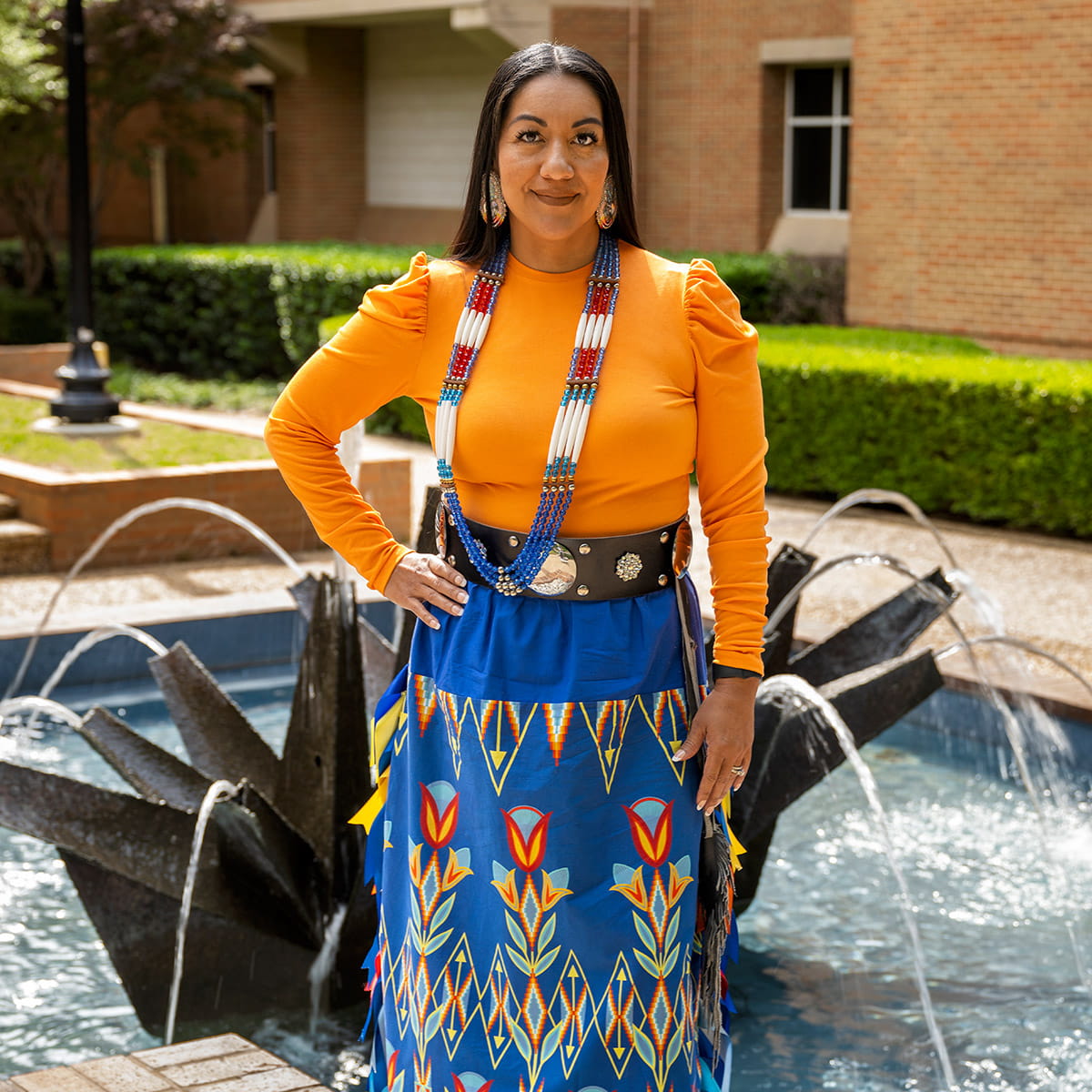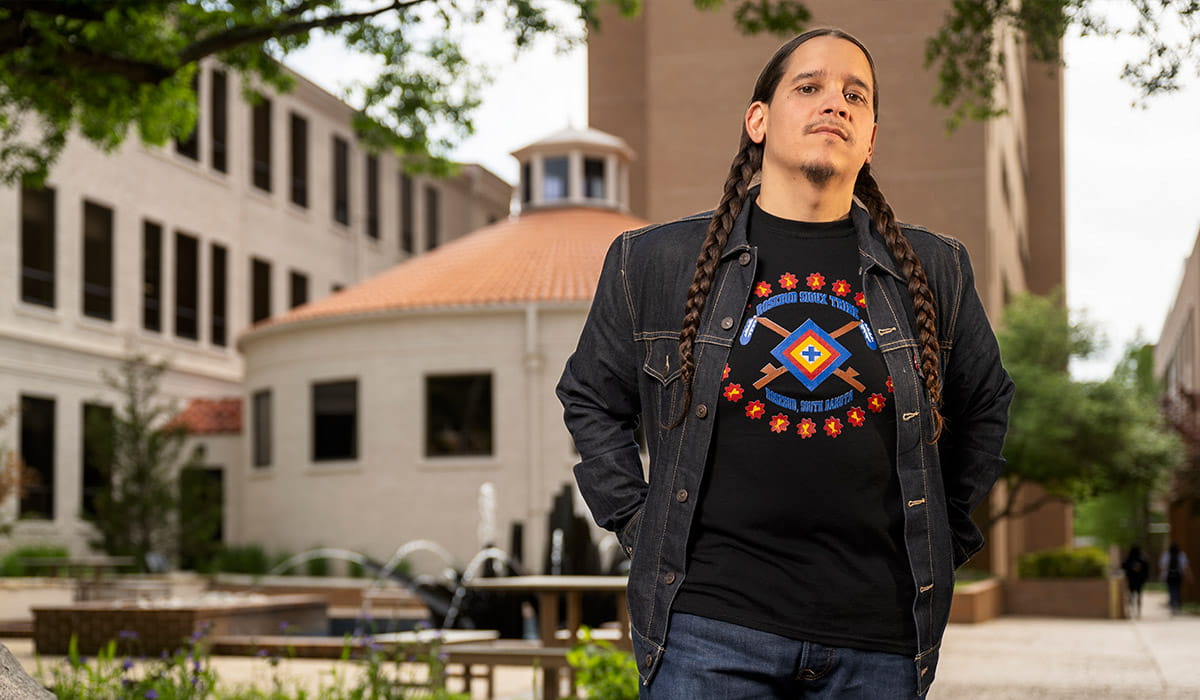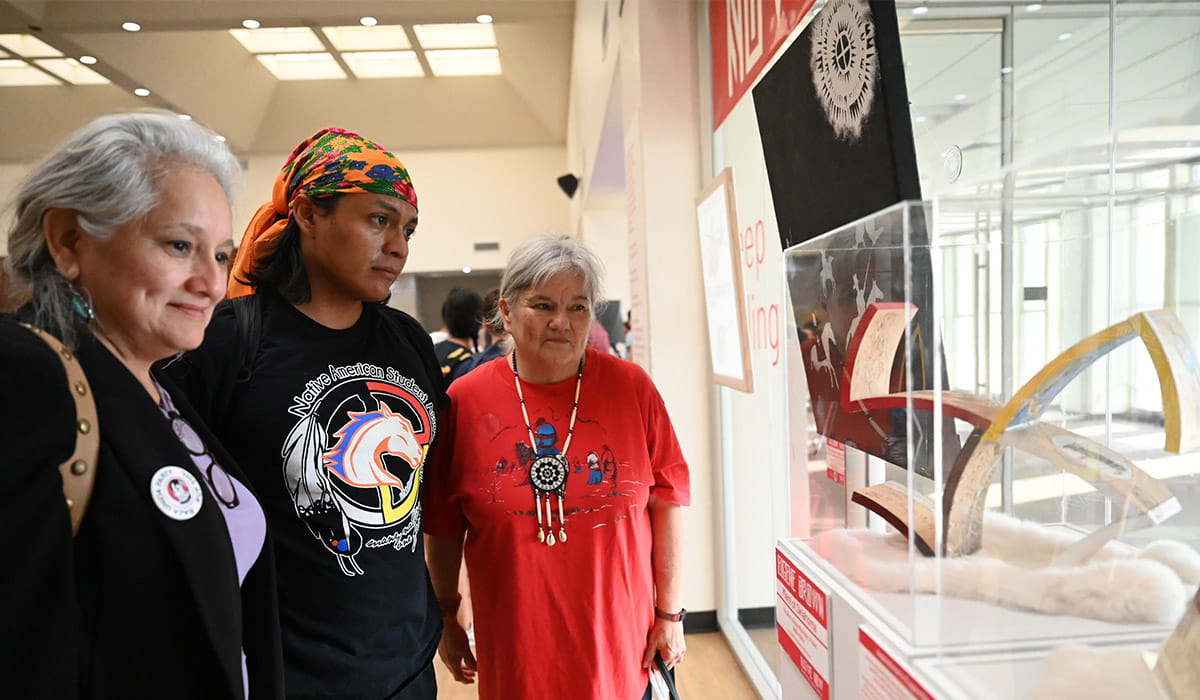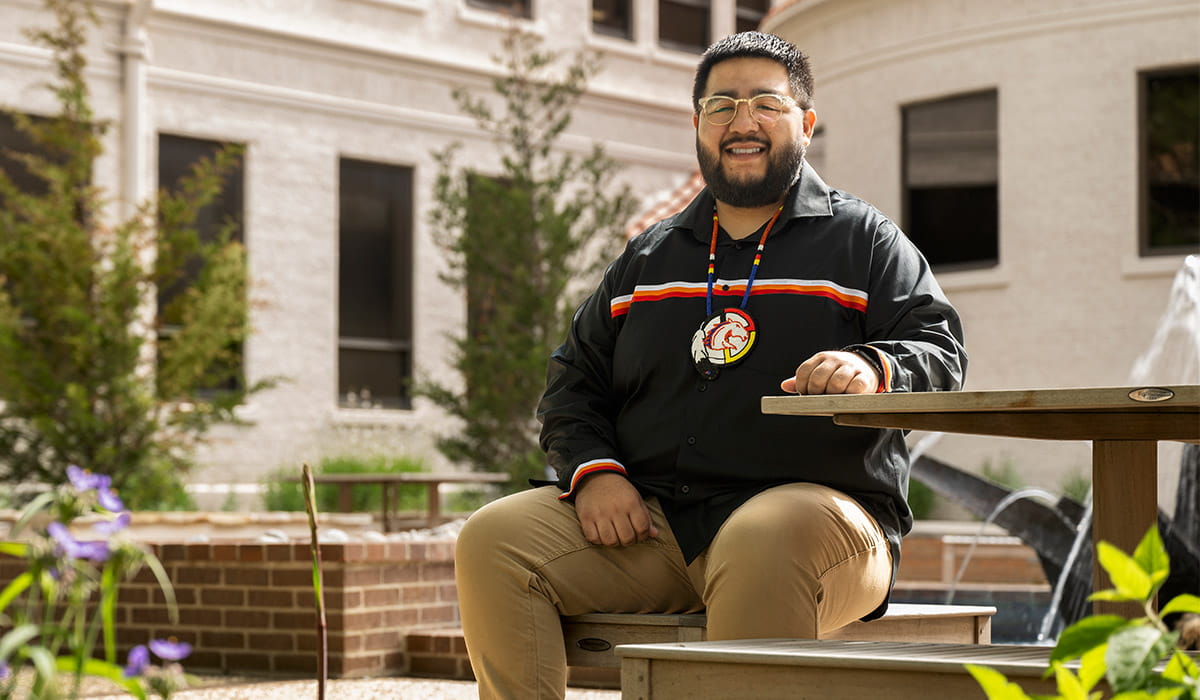University Administration Building
701 S. Nedderman Drive, Ste 421
Arlington, TX 76019-0116
Honoring the Past, Forging the Future
UTA’s support of Native American students and communities spans several decades. Today, the community is stronger than ever and looking forward to a bright future.
BY NEPH RIVERA

On UTA’s east campus, close to the Central Library, stands a physical representation of the impact of the Native American and Indigenous community. Designed by UTA students in Professor David Hopman’s landscape architecture class, a monument and Native American Land Acknowledgement Courtyard were dedicated on Indigenous Peoples’ Day, Oct. 10, 2022, with the help of members and past presidents of UTA’s Native American Student Association (NASA). Within the courtyard are a fountain, seating area, and a garden filled with native plants used for practical and ceremonial purposes. A bronze plaque commissioned by Daryl Lauster, sculptor and art professor, displays the Land Acknowledgement made by the University earlier in the year.
To have that courtyard centrally located on campus, where hundreds of students pass every single day, is something that is truly unique for UT Arlington,
says Les Riding-In, NASA advisor and assistant dean for academic affairs for the College of Liberal Arts. It sets the bar really high for other schools to do that.

Phyllis Nuno, a senior studying exercise science and current vice president of NASA, sees the Land Acknowledgement as the most impactful thing NASA has accomplished in her time at UTA.
This acknowledgement will bring light and attention to those people who came before us on these lands. And not just where campus is, but lands all over,
she says. We want to remember and honor those who came before us. I feel like the history needs to be known.
The new courtyard is also a testament to UTA’s longstanding support of its Native American students and community, support that has earned recognition nationally. For five years in a row, UTA has been listed among the nation’s best universities for Native American, Alaska Native, and Native Hawaiian students by Winds of Change, a publication of the American Indian Science and Engineering Society. The magazine evaluates and ranks the top 200 universities with strong Native American communities and academic support systems in place for student success. UT Arlington is also an Asian American and Native American Pacific Islander-Serving Institution.
Dr. Riding-In describes UTA’s current Native American culture as rich with diversity, allowing students from a variety of tribes, near and far, to play a vital role in their own development.
That’s one thing that I’ve always thought is a great benefit about UTA,
he says. It is such a large university, but it is so welcoming to Indigenous and Native populations. It’s something that characterizes a Native American student coming to UTA: the ability to forge their own path.
A Deep History
UTA’s involvement with the Native American community, particularly in North Texas, can be traced back to at least the 1950s, when the region was part of a federal urban relocation program that prompted Native American families to move from various reservations to live and work in metropolitan areas. These families saw the chance to attend UTA as invaluable.
They saw this as an opportunity to gain skills, to earn a certificate or a bachelor’s degree,
says Riding-In. I think that provided UTA a lot of momentum with the Indigenous community.
Another boost would come in the spring of 1972. Kenneth Roemer was about a year into his tenure as assistant professor of English when Emory Estes, then chair of the department, asked him a question that arguably sparked UTA’s involvement in exposing students to Native American culture in the classroom: Do you think you can teach a course on American Indian literature?

Dr. Estes had a personal interest in the course as a member of the Cherokee Nation of Oklahoma. He also knew that Dr. Roemer, today a UTA professor emeritus, worked at an Indian center in New Mexico and, for three generations, had family who worked for and with Lakota and Dakota families.
In a detailed history written by Roemer and Riding-In titled A Happy Alliance: UTA and the DFW Indian Communities, Roemer recounted the meeting, calling the request “ridiculous,” especially since only one such course had ever existed.
There weren’t any courses in that, so I wasn’t prepared. There were also no textbooks,
Roemer says. I had to use the real old-fashioned mimeograph purple, smelly stuff to create things. It was out of the blue. But it was an exciting time because it was just starting up and I got in on the ground level.
Roemer also credits Thomas Watts, a longtime professor in the School of Social Work, for his teaching of Native American courses.
Continued Growth
The evolution of the Native American experience at UTA would hit a major crescendo in 1985, when the Department of English hosted Southwestern Indian Literature in Context, a two-month festival that brought lectures, readings, films, and photo exhibits to campus. The event attracted authors, artists, and experts in the name of introducing Dallas-Fort Worth residents to what a poster for the event called “a rich but neglected body of ethnic, regional literature.”
Then, in 1994, came the founding of NASA. In A Happy Alliance, Roemer called it “the major continuous link between the University and the community.” His involvement began in 1995, when the group’s founders approached him to ask if he would be their advisor. Roemer said yes, launching years of what he called “one of the coolest experiences” he has had at UTA. He adds that the founders provided leadership and stability that has stood the test of time. Today, the group, open to all, is Texas’ longest continuously running Native college student organization.
I think if it hadn’t been for that rock-solid group at the beginning, I might not have felt that something like this could be carried on,
he says.
Today's Students
That strong foundation is being built upon still today in members like Stephen Silva Brave, who is pursuing his Bachelor of Social Work degree. Looking back, Brave points to two events that drove him to get involved with the organization as a member and for a term as vice president. The first was in November 2021, which happened to be Native American Indian Heritage Month. Roemer and another student invited Brave to attend an event discussing the ongoing troubling trend of violence against Indigenous women.
The second key event was the annual UTA Powwow, which marked its 27th year in 2023. Brave says he felt a duty to get involved with the Powwow and Native American student life on campus in general, especially as in-person activities returned after the height of the pandemic.
I felt like I had to get involved,
Brave says. Not that I could change it or save it. But it was my responsibility.

Sampson Dewey, NASA president, knew he wanted to be involved with the organization before he was even a UTA student. Dewey, who was born in Nevada and attended high school in Abilene, Texas, was not as familiar with North Texas. He says an article in The Shorthorn on NASA drove his decision to become a Maverick. He then found the NASA table during the Activity Fair as a freshman and wound up finding a new group of friends.
As a freshman, I was a little hesitant,” says Dewey. “It was a new city, new place, new people. But they made me feel at home.
That feeling of family, he notes, extends beyond the membership roster.
Anybody who comes to UTA in general, or who joins the organization, or even knows us on a personal level is invited into a family,
he says. We are just one big community.
NASA membership always gets a boost around the Powwow, a significant event on the campus calendar. The 12-hour community celebration is considered a festive way to bring Native culture to the forefront while attracting potential new members to NASA.
Getting into the 1990s and early 2000s, a lot of the community powwows disappeared, and we were one of the ones that kept going,
says Roemer. That was another important thing we did here at UTA—keeping our Powwow going. The number of NASA members explodes at Powwow time because everybody wants to work on it.
Getting Involved, Giving Back
One hallmark of NASA membership is how dedicated its members are to the campus community and the community at large.
Our students are playing a vital role in determining land acknowledgment across the DFW area, as well as their own committee work with local organizations,
says Riding-In. That is something our students were not doing 10 years ago.

Dewey embodies that commitment here in North Texas. During his internship with the Dallas Museum of Art, he helped create a community board to assist with their Land Acknowledgement and other Native issues. Statewide, Dewey and Riding-In, along with Paul Conrad, associate professor of history, sit on a UT System board that focuses on issues among the Indigenous community.
For Nuno, the community impact of NASA is exemplified in the Powwow. She points out that scholarship funds raised through the event support all students, whether they are Native or not.
If they are qualified, they are able to get those scholarships,
she says. That’s big because we’re giving back to other communities as well, not just our people. I believe in uplifting everyone.
Brave and Roemer are also part of a group working with the Grand Prairie Independent School District on an American Indian/Native Studies pilot course, and Brave is a volunteer member of the organization Missing and Murdered Indigenous Women TX Rematriate, which aims to reunite missing Indigenous women with their families.
I don’t feel like I am doing meaningless activities when I am doing work with the Native American Student Association,
says Brave. I feel like I’m doing advocacy work and things for a bigger purpose.
Looking Ahead
Both Roemer and Riding-In say overall institutional encouragement has helped make the Native American student experience as rich as it is today. Roemer points out that recent support from UTA leadership, like President Jennifer Cowley and Provost Tamara Brown, are helping bring NASA to another pinnacle.
Riding-In echoes the importance of University support. I think [the courtyard] is a tremendous showing of dedication,
he says. Multiple offices on campus had to work together, from the President’s Office all the way down to individual departments.

Though Riding-In calls UTA’s Land Acknowledgement and courtyard strong signals of support for the Indigenous population, he is quick to note that it doesn’t mean the mission is accomplished. Rather, the acknowledgement is, in his eyes, a call to build upon the progress already made.
In many ways, the call to action is us as a student group, as well as the University, continuing its support over the next decade toward Indigenous populations,
Riding-In says. We do that through scholarships. We do that through having more Indigenous mentors on campus and continuing our efforts in proliferating the Indigenous population at UTA.
Dewey agrees. The hard work that we put in isn’t just for us,
he says. It’s for building our community. It’s for giving the next generation not just the same foundation, but a stronger one.
You Might Also Like

Advocates for All
Coming from an underserved community, Ashley Torres wants to be what her family and her community did not have when she was growing up.

FROM THE PRESIDENT
This May, during an already exciting time for the University—commencement season!—I am thrilled to share that we celebrated a major milestone in University history.

Scholarship
“This scholarship made a life-changing impact on me,” Hernandez says. “Like a domino effect, the experiences I’ve had the pleasure to enjoy have all come from extended opportunities provided by generous donors to proceed with my studies.”